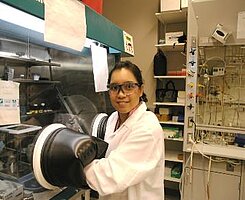Polymer Modified Zero-valent Iron Nanoparticles for Arsenic Remediation: Longevity and Ionic Strength Effect Studies (Final Phase)

Sita Krajangpan is a Ph.D. student in Civil Engineering at North Dakota State University. She holds a M.S. in Environmental and Hazardous Waste Management (Chulalongkorn University, Bangkok, Thailand, 2005) and a B.S. in Environmental Science (Chulalongkorn University, 2002) and a diploma in Analytical Chemistry (Chulalongkorn University, 2000). Currently, her research is focused on developing a metal nanoparticle delivery system for groundwater remediation.
Email: sita.krajangpan@ndsu.edu
Polymer Modified Zero-valent Iron Nanoparticles for Arsenic Remediation: Longevity and Ionic Strength Effect Studies (Final Phase)
Project Background:
Zero valent iron (Fe0) nanoparticles (nZVI) have been used for groundwater remediation of various contaminants because of their unique physiochemical properties. Various chlorinated aliphatic hydrocarbons, explosive materials, and arsenic have been successfully remediated by nZVI. However, nZVI are not only highly reactive with the contaminants, but also rapidly react with surrounding media in the subsurface and other non-target compounds. Thus, significant loss of nZVI reactivity occurs before the particles reach the target contaminant. Additionally, strong Van der Waal and magnetic atteractions between particles causes agglomeration, limiting colloidal stability and reduction in reactive surface. Considering the requirements of an effective delivery system for nZVI, functionalized amphiphilic polysiloxane graft copolymers (APGC) are an ideal class of polymers for this application. The hydrophilic graft will increase colloidal stability of nZVI in an aqueous medium. The hydrophobicity of the polysiloxane polymer backbone will protect the nZVI from excessive oxidation by water/non-target compounds. The proposed APGC coated nZVI (CnZVI) was successfully synthesized under NDWRRI fellowship for 2007 and 2008. The new CnZVI here shown very good colloidal stability and enhanced contaminant degradation characteristics. The final goal of this new delivery vehicle is remediation TCE and arsenic (As) in groundwater environment. Groundwater contains monovalent (e.g., Na+, K+) and divalent (e.g., Ca2+, Mg2+) cations and they make water ionic. It is, therefore, important to know effects of ionic strength on CnZVI. Longevity (shelf-life) of the coated nanoparticles will be checked through sedimentation and degradation studies.
The present research is in continuation of the work proposed for the 2008 NDWRRI program.
Project Objectives:
The main objective of this study is to enhance the effectiveness and longevity of CnZVI for groundwater remediation. The specific objectives of the study are as follows:
- Fine tune the design of the modified nZVI (i.e., CnZVI) for effective degradation of Arsenic (and also TCE, NO3--N, and RDX),
- Determination of longevity (shelf-life) of CnZVI,
- Determine ionic strength effects on colloidal stability and contaminant degradation by CnZVI, and
- Study of corrosion characteristics of bare nZVI and CnZVI.
Progress:
The nZVI, APGC, and CnZVI were successfully synthesized and characterized. The colloidal stability comparison between CnZVI and bare nZVI were completed. Batch experiments using CnZVI were conducted with replications and showed promising results in As, TCE, and NO3--N removal as compare to nZVI. Shelf-life of CnZVI (over 7 month-periods) showed stable colloidal stability. Ionic strength study showed no significant change in colloidal stability and TCE removal. SEM/EDX was used to study surface corrosion of the metal particles. The results indicate that CnZVI markedly protects nZVI surface from undesired corrosion.
Research Outcomes:
Krajangpan, S., Chishlom, B., Bezbaruah, A., RFT-247, Novel Polymer Modified Iron Nanoparticles for Environmental Remediation, provisional patent application filed Feb. 2009.
Krajangpan, S., Chishlom, B., Bezbaruah, A., RFT-247, Novel Polymer Modified Iron Nanoparticles for Environmental Remediation, provisional patent application filed Feb. 2008.
Krajangpan, S., Chishlom, B., Bezbaruah, A., RFT-247, Novel Polymer Modified Iron Nanoparticles for Environmental Remediation, provisional patent application filed Feb. 2007.
Krajangpan, S., Jarabek, L., Jepperson, J., Chisholm, B., Bezbaruah, A. (2008). Polymer modified iron nanoparticles for environmental remediation. Polymer Preprint, 49, 921.
Bezbaruah, A.N., Krajangpan, S., Chisholm, B.J., Khan, E., Bermudez, J.J.E., (2009). Entrapment of Iron Nanoparticles in Calcium Alginate Beads for Groundwater Remediation Applications, Journal of Hazardous Materials, 166, 1339-1343.
Krajangpan, S., Chisholm, B.J., Kalita, H., Bezbaruah, A.N. (2009). Challenges in Groundwater Remediation with Iron Nanoparticles: Enhancement Colloidal Stability (Chapter 8) in Nanotechnologies for Water Environment Applications (Eds: Zhang, T.C., Surampalli, R.Y., Lai, K.C.K., Hu, Z., Tyagi, R.D., Lo, I.M.C.), American Society for Civil Engineers, pp 191-212. (Book Chapter)
Krajangpan, S., Jarabek, L., Jepperson, J., Chisholm, B., Protecting Iron Nanoparticles from Oxidation by Non-target Compounds and their Effective Subsurface Delivery using Amphiphilic Polysiloxane Graft Copolymers, Nano Letters. [to be submitted]
Krajangpan, S., Chisholm, B., Bezbaruah, A., December 2007. Comparative Studies of Colloidal Stability of Bare and Amphiphilic Polysiloxane Graft Copolymer Coated Iron Nanoparticles and Their TCE Degradation Kinetics. ISNEPP 2007 Nanotechnology in Environmental Protection and Pollution, Ft. Lauderdale, FL. [Presentation]
Krajangpan, S., Elorza, J., Bezbaruah, A., Khan, E., Chisholm, B., December 2007. Nitrate Removal by Zero-Valent Iron Nanoparticles Entrapped in Calcium Alginate. ISNEPP 2007 Nanotechnology in Environmental Protection and Pollution, Ft. Lauderdale, FL. [Presentation]
Krajangpan, S., Jarabek, L., Jepperson, J., Chisholm, B., Bezbaruah, A. April 10 2008. The Use of Multifunctional Polymers to Effective Deliver Iron Nanoparticles to Subsurface Contaminants. 235th ACS National Meeting, New Orleans, LA. [Poster]
Krajangpan, S., Bezbaruah, A., Chisholm, B. April 2008. Effective Delivery of Modified Iron Nanoparticles by Amphiphilic Polysiloxane Graft Copolymer for Groundwater Remediation. The 2008 Surface Water treatment Workshop, Moorhead, MN. [Poster]
Krajangpan, S., Bezbaruah, A., Chisholm, B. August 2008. Groundwater Remediation using Polymer coated iron nanoparticles. The 2008 2nd Annual Joint Student Environmental Conference. North Dakota, ND. [Presentation]
Krajangpan, S., Bezbaruah, A., Chisholm, B. October 2008. Increased Efficacy of Zero-valent Iron Nanoparticles in Groundwater Remediation: Development of Polymeric Delivery Vehicle. The 2008 International Environmental Nanotechnology Conference: Applications and Implications, Chicago, IL. [Poster]
Krajangpan, S., Bermudez, J.J.E., Bezbaruah, A.N., Chisholm, B.J., Khan, E. August, 2008. Nitrate Removal by Entrapped Zero-Valent Iron Nanoparticles in Calcium Alginate, 12th International Conference on Integrated Diffuse Pollution Management (IWA DIPCON 2008), Khon Kaen University, Thailand. [Presentation]
Significance:
Successful development of a delivery vehicle for iron nanoparticles will have broader ramifications in the field of groundwater remediation. Targeted delivery of the nZVI will save resources and time needed for remediation of contaminants in the subsurface and, thus, will help in protecting our water resources. Successful development of a polymeric delivery vehicle (APGC) can also be pilot tested to create a reactive barrier/wall to contain the arsenic trioxide plume in southeast North Dakota. The results from this project will stimulate further research for the development of target specific delivery vehicles for contaminants of environmental concern.

Achintya Bezbaruah
Civil & Environmental Eng.
Office: Civil/Ind Eng 201G
Telephone: 701-231-7461
Email: a.bezbaruah@ndsu.edu

Bret Chisholm
Center for Nanoscale Science and Engineering
NDSU


